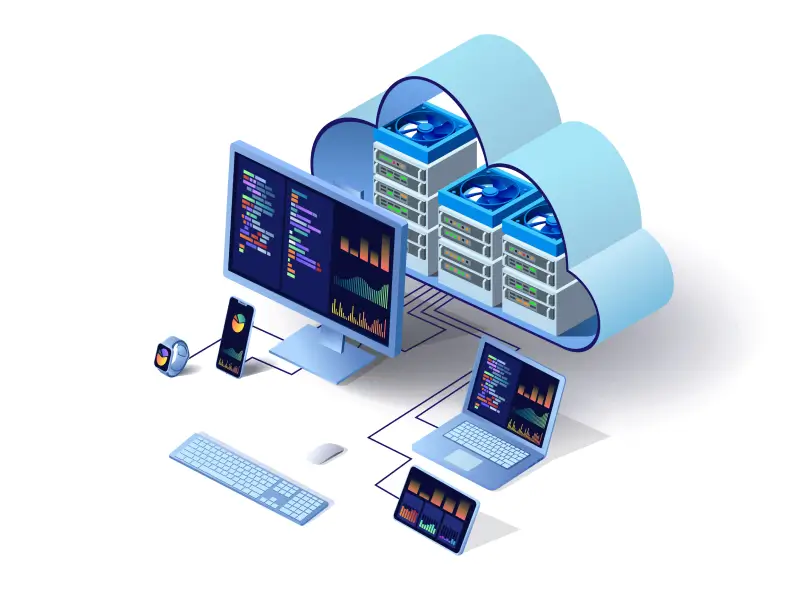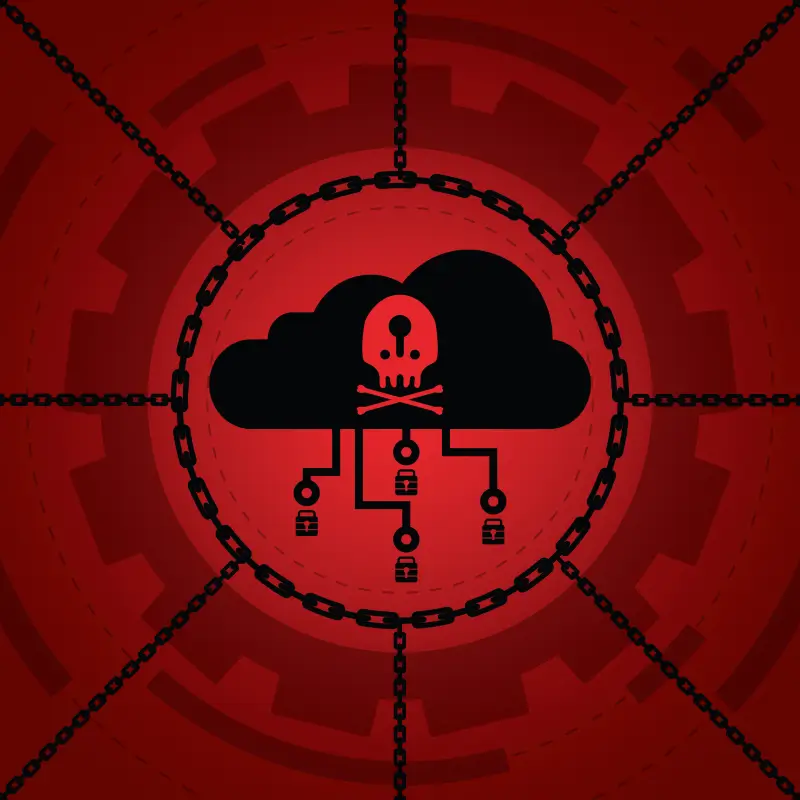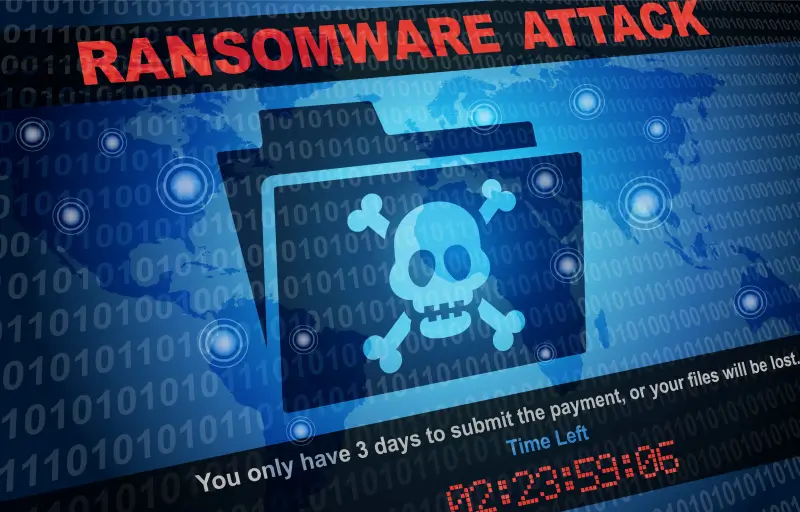Data is as valuable as currency; the shift towards cloud storage in the current digital age has been both a strategic move and a necessity for businesses and individuals alike. However, this shift presents several challenges, particularly in cybersecurity, as ransomware significantly threatens the integrity and availability of data stored in the cloud.
The reality is that cloud storage, while offering numerous benefits like scalability, accessibility, and cost-efficiency, is not inherently immune to ransomware attacks. As we delve deeper into this issue, it's crucial to understand that cloud storage can provide significant data protection advantages, such as flexible recovery options. Still, it is not a silver bullet against the sophistication of modern ransomware attacks. This underscores the importance of error resolution and prevention of sudden data loss. Secure Data Recovery, a leader in RAID, SSD, and hard drive recovery, highlights the vulnerability of cloud storage to ransomware.
The Intersection of Ransomware and Cloud Storage
Cloud storage represents a paradigm shift in data storage and management. It offers a model where data is transmitted and stored on remote storage systems, which can be accessed and managed over the internet. This model allows users and organizations to store data offsite in data centers operated by third-party cloud service providers. The key appeal of cloud storage lies in its scalability, allowing storage capacity to be adjusted according to needs and accessibility. With cloud storage, users can access data from multiple devices and locations, so long as they have an internet connection.

Integrating cloud storage into the fabric of data management has brought a unique vulnerability - ransomware attacks. Understanding these vulnerabilities and attack methods is crucial in understanding the intersection between ransomware and cloud storage.
Vulnerability of Cloud Storage to Ransomware
The vulnerability of cloud storage to ransomware is a multifaceted issue that arises from the inherent characteristics and operational models of cloud services. One of the primary factors contributing to this vulnerability is the centralized nature of cloud storage. Centralization offers significant benefits in terms of efficiency and scalability, but it also presents a lucrative target for cybercriminals. By successfully breaching a single point within the cloud infrastructure, attackers can potentially gain access to a vast repository of data belonging to multiple users or organizations. This centralized data aggregation heightens the risk and potential impact of ransomware attacks, as a single successful breach can lead to widespread data encryption and loss.
Another aspect that adds to the susceptibility of cloud storage is its inherent accessibility. While this feature is pivotal for ensuring user convenience and seamless data access, it inadvertently creates more opportunities for security breaches. Cybercriminals often exploit inadequately secured user accounts, leveraging weak authentication practices or capitalizing on unpatched system vulnerabilities. These security gaps serve as entry points for ransomware, enabling attackers to infiltrate cloud systems and encrypt stored data. The ease of access to cloud storage, intended to facilitate user interaction, thus becomes a double-edged sword, potentially exposing the system to various cyber threats.
Moreover, the complexity of cloud infrastructure itself can inadvertently introduce security loopholes. As cloud environments grow more intricate, with an increasing array of services and integrations, maintaining a comprehensive security posture becomes more challenging. This complexity can lead to security gaps, particularly when organizations transitioning to the cloud fail to implement adequate measures.
Understanding Ransomware’s Impact on Cloud Security
The adoption of cloud storage has increased in the wake of the COVID-19 pandemic and expanded the attack surface for cybercriminals. These adversaries are drawn to the wealth of the data housed in cloud services, from personal data in public clouds to sensitive corporate information in private and hybrid clouds.
Cybercriminals are exploiting these new vulnerabilities, and the statistics are alarming. According to Statista, organizations worldwide detected 493.33 million ransomware attempts. A Check Point report also shows that 1 in 31 organizations worldwide experienced a ransomware attack weekly over the first quarter of 2023. These figures are further compounded by findings from an IDC survey, which revealed that 98% of companies experienced at least one data breach in the cloud in the previous 18 months.
This surge in ransomware threats coincides with the increased use of cloud storage and cloud-based applications. Organizations now deploy hundreds of cloud-based apps, exponentially increasing the number of identities accessing their systems, thereby expanding the attack surface for cybercriminals. Despite robust identity and access management controls cloud vendors provide, vulnerabilities persist. Recent research in cloud security revealed that over 70% of organizations had public-facing cloud instances linked to vulnerable identities, potentially exploitable for cloud ransomware attacks.
The Shift to Cloud-Based Ransomware
The transition to cloud environments has not rendered traditional ransomware software obsolete; instead, it has led to the emergence of new ransomware variants specifically designed for cloud environments. These attacks, often initiated via sophisticated phishing schemes, target cloud-based applications like email services. For example, an attack on cloud-based email accounts can lock out users and disrupt critical communication channels, demonstrating the heightened risk ransomware poses to cloud storage systems.
Gaining Access Through Synchronization
One of the critical vulnerabilities in cloud storage arises from the synchronization processes that most cloud services utilize. Ransomware can manipulate these processes; when a local file infected with ransomware gets synchronized to the cloud, it results in the encryption of the cloud-stored files. This synchronization mechanism was demonstrated in a ransomware attack on the University of California, San Francisco's School of Medicine in June 2020. In this incident, the Netwalker ransomware group targeted the university's School of Medicine, where a single infected email led to the encryption of thousands of files in a cloud storage service, highlighting the domino effect that ransomware can have in cloud environments.
The Escalating Threat Landscape
As cloud services become integral to business operations, they become more attractive targets for ransomware attacks. Cybercriminals are constantly refining their strategies to exploit cloud infrastructures. The global increase in cloud service spending signals these services' critical role, making them lucrative targets for attackers. These threat actors now specialize in crafting ransomware that can navigate and exploit cloud infrastructures, recognizing the high-value data stored within these environments.
The Shared Responsibility in Cloud Security
Cloud security is a shared responsibility. Providers must secure the cloud infrastructure, including the physical data center and access to servers, but customers must also take active steps to protect their data. This includes implementing robust access controls, encrypting data, and regularly monitoring for unauthorized activity. The shared responsibility model is pivotal in cloud security, highlighting the need for collaborative efforts to ensure comprehensive protection against ransomware and other cyber threats.
How Common Cloud Storage Ransomware Works

Cloud ransomware mirrors traditional ransomware. The cybercriminal uses some method to gain access to the cloud or exploits vulnerabilities in a service's security system. Once inside, they can deliver the ransomware and infect all devices connected to the cloud.
The ransomware encrypts the victim's files, making them inaccessible without the decryption key. Often, the attacker offers to provide this key to the victim after payment of the ransom. Some actors will attempt to exfiltrate that data from the cloud and threaten to expose it for more leverage in a technique called double extortion.
These attacks have evolved to exploit cloud environments' unique characteristics and vulnerabilities. Here's an overview of the main types of cloud ransomware attacks:
Ransomware-Infected File-Sharing Services
This form of attack targets file-sharing services that are synchronized with cloud platforms. The attack begins by encrypting files on a local machine and then spreads to the cloud repository, encrypting data stored there. These attacks often originate from an infected end-user device and can spread rapidly through the synchronization mechanisms of the cloud service.
RansomCloud Attacks
RansomCloud is a newer form of ransomware that targets explicitly cloud-based services, such as email platforms like Office 365. Attackers use phishing techniques to gain access to user accounts, encrypt emails, and then demand a ransom. The nature of these attacks also allows the attackers to impersonate the account owner, potentially tricking the victim’s contacts into spreading the ransomware further.
Ransomware Targeting Cloud Vendors
Instead of focusing on individual organizations, some attackers target cloud service providers directly. This strategy aims to exploit vulnerabilities within the cloud infrastructure itself. A successful attack against a cloud service provider could lead to widespread data encryption across the provider's entire network, impacting multiple organizations simultaneously.
Other Attack Vectors in the Cloud
Cyberattacks that exploit the unique vulnerabilities of cloud systems can range from exploiting unsecured user accounts to manipulating complex infrastructure configurations. Understanding these cloud-specific attack vectors is essential in recognizing the full scope of ransomware threats and in formulating effective defenses against them.
- Denial-of-Service (DoS) Attacks. These attacks inundate cloud services with overwhelming traffic, which can cause significant disruptions in accessing cloud storage and applications. During a DoS attack, cloud resources become overloaded and may fail to respond to legitimate requests. This disruption creates a chaotic environment that can reduce the effectiveness of security monitoring, making cloud systems more vulnerable to ransomware deployment. Attackers might use this period of confusion and weakened security to slip ransomware into cloud storage systems, encrypting data and demanding a ransom for its release.
- Account Hijacking. Attackers gain control of cloud accounts through methods like phishing, credential theft, or exploiting security vulnerabilities. Once they have access, they can manipulate cloud storage systems, deploying ransomware that encrypts critical data stored on the cloud. This type of attack can have widespread implications, as the hijacked accounts often have broad access privileges, allowing the ransomware to propagate through interconnected cloud services and databases.
- User Account Compromise. This social engineering tactic involves tricking users into providing their cloud account credentials. It is often accomplished through phishing or exploiting personal information. Once attackers gain access to a user’s cloud account, they can unleash ransomware within the cloud environment, targeting stored data and cloud-based applications. This method is particularly effective in cloud environments with interconnected user accounts and extensive access to various resources.
- Cloud Malware Injection Attacks. Attackers target vulnerabilities in cloud infrastructure or applications to inject malware, including ransomware. This could involve adding a malicious service module to a Software-as-a-Service (SaaS) platform or inserting an infected virtual machine into an Infrastructure-as-a-Service (IaaS) setup. Once the malware is inside the cloud environment, it can encrypt data across the cloud storage, leading to extensive data loss and operational disruption.
- Insider Threats. Insider threats occur when employees or contractors with legitimate access introduce ransomware to the cloud. This could happen through malicious intent, negligence, or being tricked by external attackers. The insider’s deep knowledge and access to the cloud infrastructure make these threats particularly challenging to detect and prevent.
- Side-Channel Attacks. These sophisticated attacks exploit information leakage from the physical implementation of cloud systems. By placing a malicious virtual machine on the same physical server as the target, attackers can extract sensitive information, like encryption keys, and use this data to craft ransomware attacks tailored to the cloud environment’s specific vulnerabilities.
- Cookie Poisoning. In cloud applications, attackers can modify or inject malicious content into cookies, which are used to store user preferences and session information. By poisoning these cookies, attackers can gain unauthorized access to cloud storage, manipulating user sessions to deploy ransomware and encrypt data stored in the cloud.
- Security Misconfiguration. Misconfigurations in cloud settings, such as improper access controls or failure to patch vulnerabilities, create openings for ransomware attacks. Attackers exploit these security gaps to access cloud storage systems, deploying ransomware to encrypt data and potentially exfiltrate sensitive information.
- Insecure APIs. Cloud services often rely on APIs for interaction and data exchange. Attackers can exploit vulnerabilities in these APIs to gain unauthorized access and introduce ransomware into the cloud environment. This can lead to widespread data encryption and loss of data integrity in cloud-based applications and storage systems.
- Cloud Cryptomining. Though primarily a tactic for unauthorized cryptomining, exploiting cloud resources for this purpose can expose underlying security vulnerabilities. These vulnerabilities, if left unaddressed, could be used for ransomware attacks. Such attacks would not only encrypt cloud-stored data but could also significantly impair the performance and availability of cloud resources.
Each of these attack vectors underscores the need for vigilant and comprehensive security practices in cloud environments to protect against the ever-evolving ransomware threat.
Prevention and Protection Against Cloud Storage Ransomware Attacks

Maintaining robust prevention and protection strategies is paramount to navigating the ransomware threat. Organizations must adopt a multi-layered approach to effectively safeguard cloud storage against ransomware attacks, focusing on encryption, access control, API security, cloud security posture management (CSPM), and other best practices.
Encrypt All Data in the Cloud
Encryption is a critical line of defense in protecting cloud-stored data from unauthorized access. This involves converting data into a format unreadable without a specific decryption key, ensuring that even if attackers access the data, they cannot decipher it.
Encryption should be applied at three stages:
- At-rest encryption: protects data stored on cloud services or devices, ensuring it remains secure when not in use.
- In-transit encryption: safeguards data as it travels across networks, preventing interception and unauthorized access.
- In-use encryption: achieved through techniques like homomorphic encryption that allows data to be processed while encrypted, ensuring protection throughout its lifecycle.
Control Access to Cloud Services
Limiting access to cloud services is crucial in minimizing the attack surface. This strategy involves granting cloud resource access only to those who require it for their specific roles, thereby reducing the likelihood and potential impact of an attack.
Examples include:
- Restricting cloud storage access to prevent data theft.
- Limiting access to cloud-based applications to avoid unauthorized operations, such as denial-of-service attacks.
- Controlling infrastructure access to prevent compromises of virtual machines and other cloud resources.
Enforce Secure API Access
APIs are pivotal in cloud environments, acting as gateways to cloud applications and data. Securing these APIs involves implementing authentication and authorization mechanisms, such as token-based authentication and role-based access controls. Additionally, validating data received from clients ensures that it is free from malicious payloads.
Leverage a CSPM Solution
Cloud security posture management (CSPM) tools play a vital role in managing and securing cloud assets. They aid in asset management, compliance adherence, and threat detection by providing visibility into the security posture of cloud assets and monitoring for unusual activity.
Adopt a Least-Privilege Access Strategy
Implementing a least-privilege model involves granting the minimal necessary permissions for users to perform their jobs. This strategy includes making cloud buckets private, separating permissions to access and alter cloud resources, and removing inactive users or functions.
Remove Risk Factors
Regular scans of the infrastructure to identify and mitigate risks are essential. This includes rotating access keys, enabling multi-factor authentication, and disabling unused credentials. Continuous monitoring is key to maintaining security.
Prevent Delete Operations
Utilize native cloud service features to prevent malicious deletions. For example, AWS has MFA Delete and Object Locks. These mechanisms restrict the deletion of objects and require additional authentication steps for certain operations.
Replicate Buckets
Configuring cloud buckets to back up contents to a dedicated location automatically can mitigate the impact of ransomware on data availability and integrity.
Educate Employees
Regular security awareness training helps employees identify and respond appropriately to potential ransomware threats, such as suspicious emails and attachments.
Backup Data Securely
Regular, secure data backups, both in the cloud and locally, are essential for recovery in the event of a ransomware attack. Using cloud-to-cloud backup providers can enhance this security measure.
Use Anti-Phishing Tools and Real-Time Auditing
Deploy cloud-based anti-phishing solutions and real-time auditing tools that employ machine learning to detect and respond to suspicious activities. Threshold alerting can identify and mitigate events indicative of a ransomware attack.
Block Malicious Websites and Apps
Monitor and control the installation of third-party applications, including mobile apps and browser extensions, to prevent access to malicious websites and the installation of harmful software.
Install Updates/Patches
Regularly update and patch all software to protect against known vulnerabilities that could be exploited in a ransomware attack.
Use Multiple Cloud Providers
Diversifying cloud service providers can ensure business continuity in the event of an attack on one provider. However, visibility across multiple platforms is crucial for effective event monitoring.
Prepare a Disaster Recovery Plan
A well-prepared disaster recovery plan is essential for a timely, effective response in the event of a ransomware attack. This plan should encompass safe backup practices and reliable recovery mechanisms.
Implementing these strategies can enhance an organization's resilience to ransomware attacks in the cloud, ensure sensitive data is protected, and maintain continuity.
Verdict: Can Ransomware Affect Cloud Storage?
The answer is unequivocally yes – ransomware can and does affect cloud storage. The centralized nature of cloud storage, combined with its inherent accessibility and complex infrastructure, makes it a vulnerable target for ransomware attacks. Despite the robust security measures typically employed by cloud service providers, the shared responsibility model in cloud computing means that users must also play an active role in safeguarding their data. The emergence of sophisticated ransomware tactics, including attacks that specifically target cloud environments, further underscores the vulnerability of cloud storage to these threats.
However, it's important to note that while cloud storage is susceptible to ransomware, it also offers unique data recovery and resilience advantages. With the right strategies in place — such as regular data backups, encryption, stringent access controls, and the use of advanced security tools — the risks posed by ransomware can be significantly mitigated.
Therefore, while cloud storage is not immune to ransomware, understanding its vulnerabilities and adopting comprehensive security measures can greatly reduce the risk and impact of such attacks.
Emergency Ransomware Data Recovery Services

Time becomes critical during a ransomware attack, especially when business operations are disrupted. Secure Data Recovery emergency ransomware data recovery services are designed to minimize downtime, providing swift and efficient solutions to restore your data. We understand the urgency of these situations and work tirelessly to recover your valuable information.
Our engineers have provided ransomware data recovery since 2007. In that time, they have seen it all. Their experience and expertise with multiple devices and failure scenarios can reunite you with your data.
We offer flexible services, including emergency data recovery. We offer a free media diagnostic and quote as part of those services. We back it with a “No Data, No Recovery Fee” guarantee. You get your data back, or you pay nothing.
Call us at 800-388-1266 to speak with a specialist and start your case today.







